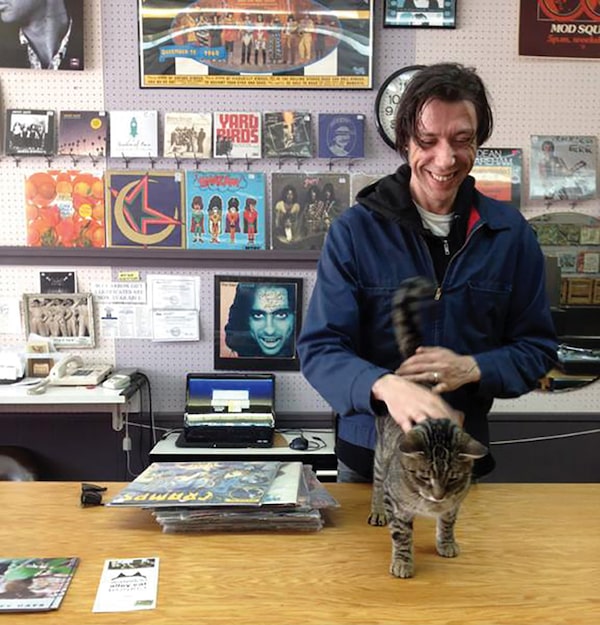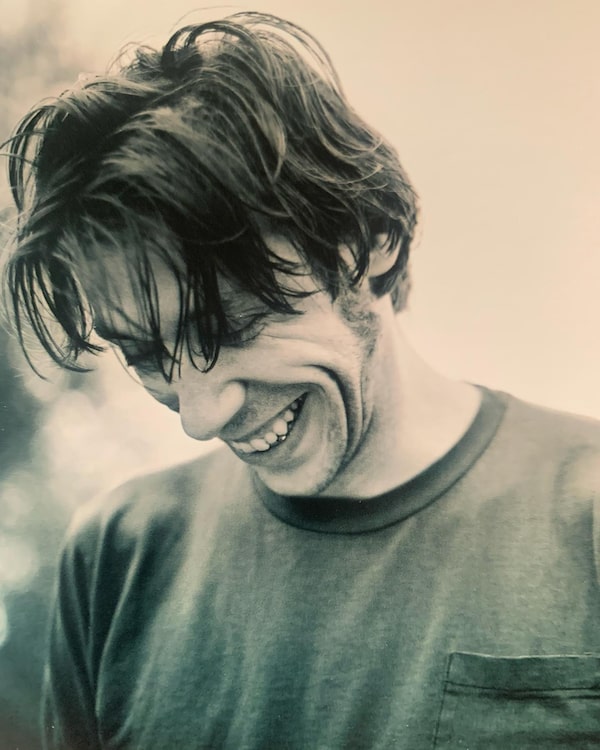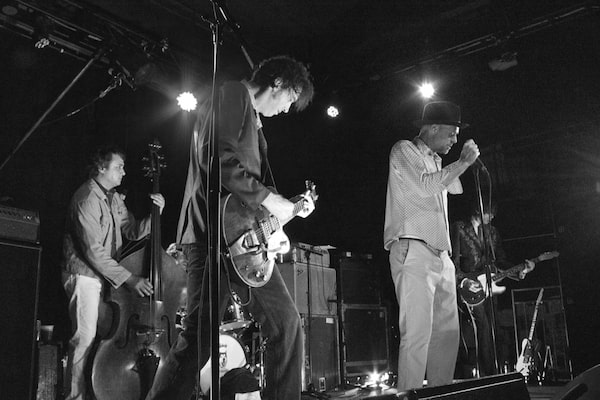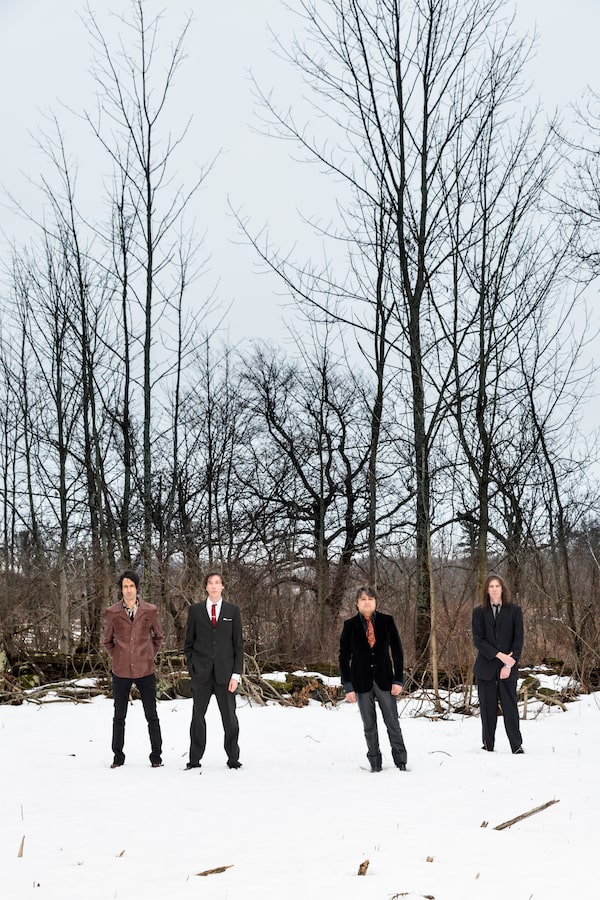The Sadies lead singer Dallas Good in Toronto on Jan. 25, 2017. Mr. Good died Feb. 17 of natural causes while under doctor’s care for a coronary illness discovered earlier in the week. He was 48.Nathan Denette/The Canadian Press
In 2013, the Jim Jarmusch film Only Lovers Left Alive screened at the Toronto International Film Festival. Because the filmmaker’s friends singer-songwriter Patti Smith and guitarist Lenny Kaye were in town, the American filmmaker invited them to the gala presentation. They were busy, however, giving a concert at Massey Hall the same evening. They would not be able to attend.
When Mr. Jarmusch mentioned that the Canadian band the Sadies would be playing an after-party for the film later that night, however, Ms. Smith and Mr. Kaye told the director without hesitation that they wouldn’t miss the performance for the world. Such was the standing of the Toronto-based Sadies, a quartet of cosmic-country rockers unknown to most but deeply revered by many.
Sadies singer-guitarist Dallas Good died Feb. 17 of natural causes while under doctor’s care for a coronary illness discovered earlier in the week. He was 48.
The group was led by Mr. Good and his older brother, the fellow singer-guitarist Travis Good. Their father, Bruce Good, and uncles Brian and Larry are the namesake members of the Good Brothers, folky bluegrass pioneers of a previous generation.
While the late Mr. Good was one-fourth of the Sadies’ long-running membership, he seemed to occupy the dominant portion of the band’s soul. Easily cool and possessing a baritone voice, he cast a distinguishable, timeless silhouette while performing.
“You could imagine Dallas walking on stage with Merle Haggard or Link Wray or Irma Thomas or so many artists of the past,” Mr. Jarmusch said.

While Mr. Good was one-fourth of the Sadies’ long-running membership, he seemed to occupy the dominant portion of the band’s soul.Blue Arrow Records
The Sadies released nine studio albums of their own, while collaborating with an eclectic roster of artists that included singer-songwriter Neko Case, American R&B veteran Andre Williams and, for the ferocious 2014 album And the Conquering Sun, the Tragically Hip’s Gord Downie.
Mr. Good and the Sadies rhythm section joined forces with Rick White of Eric’s Trip and Blue Rodeo’s Greg Keelor to form the psychedelic-rock supergroup the Unintended. They released a self-titled album in 2004. In a social-media post last week, Mr. Keelor said Mr. Good had inspired him and many others to “go deeper” into the music.
The Sadies recently released Message to Belial, a haunting song rich in vocal harmony and dire in its warning: “Last chance for salvation, end of all nations.” This month, the group performed at a virtual edition of the Hillside Inside festival in Guelph, Ont.
Formed in the mid-1990s, the Sadies have a reputation as indefatigable performers and unpretentious show-offs who dazzle with electric-twang musicianship, confront with punk energy, haunt with vocal harmonies, present handsomely in country-music threads and impose with a unique northern gothic ambiance.
“The Sadies are Canada’s best-kept secret,” said Ron Mann, another filmmaker friend of the band. “They are the sound of the unexpected.”
Songs written collectively by Mr. Good and other Sadies were impressionistic and elegantly gloomy. The most recent album by the Sadies, 2017′s Northern Passages, includes Another Season Again: “I don’t need this sun, everything’ll be fine once the wintertime has begun,” Mr. Good sang.

Neighbours of Mr. Good and his wife, Amanda Schenk, remember the musician as a world-weary late riser who wore a green army jacket and a gentle disposition.John Laroque
The song continued the band’s exploration of moody themes of regret, doom and isolation. The 2010 song Another Year Again came with the line, “It won’t be long ‘til all your hopes and dreams are dead and gone.”
“Dallas was a country poet,” said Gary Louris of the seminal American alt-country band the Jayhawks. Mr. Louris produced the Sadies’ 2007 album New Seasons and 2010′s Darker Circles.
On stage, the gaunt Mr. Good strapped on a red Fender Telecaster to envelop himself in a fog of mystique and amplified reverb.
“Dallas carried a weight on him that was beyond his years,” Mr. Louris told The Globe and Mail. “He was Pink Floyd meets Porter Wagoner.
Neighbours of Mr. Good and his wife, Amanda Schenk, remember the musician as a world-weary late riser who wore a green army jacket and a gentle disposition.
“He was tall and beautiful to look at, with his devastating cheekbones,” said Whitehorse guitarist Luke Doucet, a neighbour on the street where Mr. Good lived in Toronto’s Junction Triangle. “And yet there was something demure and deferential about him that came across as an act of generosity on his part.”
Mr. Good and Ms. Schenk were known as highly dedicated cat-lovers. They would feed and trap feral cats and pay to get them fixed. A next-door neighbour experienced the musician’s warmth and sensitivity firsthand.
“We had an orange cat named Dorito who was killed by a car,” Victoria Stacey said. “Dallas took buckets of soapy water and a hose to clean up the site of the accident so that our kids wouldn’t have to see it. He and his wife came by later with flowers.”

The Sadies collaborated with the Tragically Hip’s Gord Downie to make the 2014 album And the Conquering Sun. The singer is shown here performing with the band.Peter Harvey
Beyond recording and a maintaining a relentless touring schedule, Mr. Good and the Sadies worked on films. They provided the soundtrack to Mr. Mann’s 2006 documentary Tales of the Rat Fink and appeared in his Carmine Street Guitars, a love letter to a famed New York music shop from 2018.
In Mr. Jarmusch’s 2019 zombie comedy The Dead Don’t Die, characters played by Danny Glover and Caleb Landry Jones allude to Dallas and Travis Good as a pair of musician brothers who “came out of the birth canal with guitars in their hands.”
Dallas Brian Good was born May 22, 1973, in Richmond Hill, Ont. He was named after American country legend Dallas Frazier. His mother, Margaret Good (née Queen), is a teacher and a singer who spent two seasons on the 1970s CTV series Grand Old Country, hosted by Ronnie Prophet. His father, Bruce Good, is an autoharp player with the Good Brothers, along with his twin brother Brian (guitar) and younger sibling Larry (banjo).
The Good Brothers won the country group Juno Award for eight straight years starting in 1977. Although Dallas Good once said that he didn’t grow up “Partridge Family-style,” he was pictured in Bluegrass Canada magazine as a toddler being washed in a bucket by his mother at a music festival.
The Good Brothers were associates of Gordon Lightfoot, whose guitarist Red Shea gave lessons to Travis Good in the 1970s. Five years younger than his brother, Dallas studied piano with a teacher who catered to his rebelliousness and innate talent. “I never practised and she noticed that, so she’d just teach me ear training,” he told Exclaim magazine in 2010.
Self-taught on guitar, he eventually emerged musically as the “quiet genius of the family,” according to his father. In the early 1990s he played with the punk band the Satanatras and the surf-rock group Phono-Comb. The Sadies (which included Sean Dean on bass and Mike Belitsky on drums) took their name from Al Capp’s satirical comic Li’l Abner.
They released their first album, Precious Moments, in 1998. It begins with Guns Speak, a 42-second surf-rock instrumental that leads into the spaghetti Western romp Dying is Easy. Over the course of eight more studio albums, the group members honed their harmonies and song writing, while crafting an evocative noir aesthetic.
On Northern Passages, the American singer-songwriter Kurt Vile contributed lyrics and vocals to It’s Easy (Like Walking), a jangling mid-tempo ramble that addresses the musical relationship between Dallas and Travis: “It’s like playin’ guitar with your brother, like planting one foot in front of the other,” Mr. Vile sings.
The Sadies and the Philadelphia-based Mr. Vile met on tour in 2010. “I thought they were pretty weird and they thought I was too,” Mr. Vile told The Globe. “We were both right.”
Mr. Vile is one of a number of artists with whom the Sadies toured and recorded. Collaborative projects include The Good Family Album (featuring the Sadies and members of the Good clan) and Garth Hudson Presents a Canadian Celebration of the Band (with the Sadies backing Neil Young on This Wheel’s On Fire and Mary Margaret O’Hara on Out of the Blue).

Formed in the mid-1990s, the Sadies have a reputation as indefatigable performers and unpretentious show-offs.Heather Pollock
In 2010, Mr. Good and the Sadies unexpectedly accompanied Margaret Atwood on a CBC radio broadcast. Undaunted by her own inexperience, the Can-Lit icon sang a twangy song called The Water-Shrew That Rends Its Prey with convincing swagger.
Despite their impressive discography, the Sadies are particularly renowned as an invincible live act. If Bob Dylan felt comfortable “going electric” in the mid 1960s with his Canadian backing band the Hawks (later to gain fame as the Band), the author Ms. Atwood was emboldened enough by her association with the Sadies to perform live with them at Toronto’s Adelaide Hall in 2013.
The band was legendary for the towering power and epic length of its shows across Europe and North America. Its New Year’s Eve concerts at Toronto’s Horseshoe Tavern were Auld Lang Syne extravaganzas.
In 2003, the Sadies toured with Mr. Louris and the Jayhawks in the United States. “We were somewhere cold, and they had a van that wouldn’t start. They might not have had a hotel room.”
On stage, however, the band transformed. “They wore the fancy country suits and put on a performance that rivalled a Las Vegas performance show by Elvis,” Mr. Louris recalled.
A concert contract stipulation provided to promoters forbid venue sound technicians from telling the Sadies to turn down their volume. Once at the luxury Creekside Villa boutique hotel in Canmore, Alta., the band was 20 minutes into their first set when the lights went out and the fire alarm went on. The confused audience was forced to go outside as staff and firemen investigated.
“It was the sheer volume of watts being pulled from the circuit breaker that shut everything down,” recalled Andy Cotter of the local opening act, Elk Run & Riot. “It was a small room, and our jaws just dropped when the Sadies brought their vintage amplifiers in and lined the wall with all their gear.”
Despite all the noise they made critically and otherwise, the Sadies never made a lot of money at the best of times. At the worst of times, namely the past two years of having concerts cancelled because of the COVID-19 pandemic, they struggled even more.
“I’m trying to ignore growing debt while incurring new ones,” Mr. Good wrote in journal he kept for a proposed documentary on the band by Mr. Mann. Stuck at home and unable to practise as much as he would like, the guitarist wrote that he was “definitely slipping” because of the inactivity.
“Some bands tour to promote a record,” Mr. Mann said, “but the Sadies tour as a way of life.”
The Sadies have shows scheduled this spring in the Prairies and Ontario. Though the band’s future is unclear, a new album, Colder Streams, is set to be released this summer. The record was produced by Arcade Fire’s Richard Reed Parry, who announced last week that he had also been working on a duo album with Mr. Good inspired by the Everly Brothers.
Mr. Good leaves his wife, Ms. Schenk; parents, Margaret and Bruce; and brother, Travis.
 Brad Wheeler
Brad Wheeler